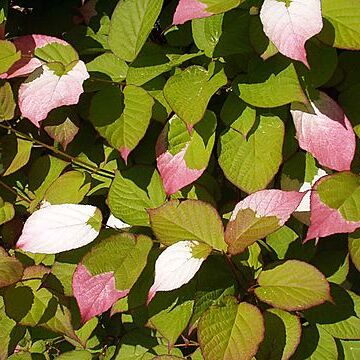Climbing shrubs, large, deciduous. Branchlets glabrous, lenticels inconspicuous to subconspicuous when young, conspicuous when old; pith brown, lamellate. Petiole yellowish white to reddish brown, 2.5-5 cm, sparsely pubescent to glabrous; leaf blade broadly ovate to oblong-ovate or oblong-obovate, 6-15 × 5-10 cm, membranous to thinly papery, abaxially glabrous to subglabrous, sometimes barbate at vein axils, adaxially sparsely strigillose, midvein and lateral veins distinct and raised abaxially, slender, inconspicuous adaxially, lateral veins 6-8 pairs, veinlets reticulate, inconspicuous on both surfaces to subconspicuous abaxially, base cordate, occasionally rounded to truncate, equal or oblique, margin serrate to biserrate, apex acute to abruptly acuminate. Inflorescences cymose, 1-3-flowered; peduncles 0.8-1.2 cm, very slender; pedicels 4-10 mm, glabrous to yellowish brown tomentose; bracts linear, minute. Flowers pink or white. Sepals 5, ovate to oblong-ovate, 4-6 mm, glabrous, margin ciliate, apex acute. Petals 5 or 6, obovate, 6-10 mm. Filaments 3-6 mm; anthers yellow, oblong, 2-2.5 mm, sagittate at base. Ovary globose, ca. 3 mm, glabrous. Fruit pale orange when mature, ovoid, 2-2.5 cm, glabrous, lenticels absent; sepals caducous. Seeds ca. 2 mm. Fl. Apr-Jul, fr. Sep-Oct. 2n = 58*, 116*.
More
A vine which looses its leaves during the year. It climbs to a height of 4-6 m. The stems are slender, woody and branching. The leaves are oval and taper towards the point. The leaves are 15 cm long and when young they have a purple tinge. They become green and blotched with cream and pink. The flowers are white. They have a sweet smell. They are shaped like a cup and 1 cm across. They occur on groups of 3. Male and female flowers occur separately on separate plants. The fruit are yellow. They are egg shaped berries 2 cm long. They are smooth. The fruit are edible.

